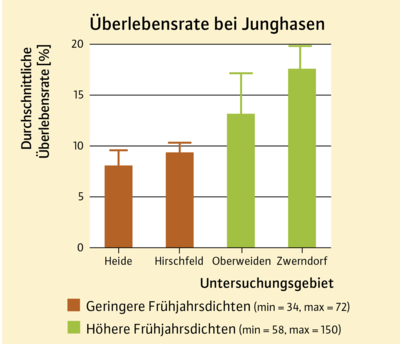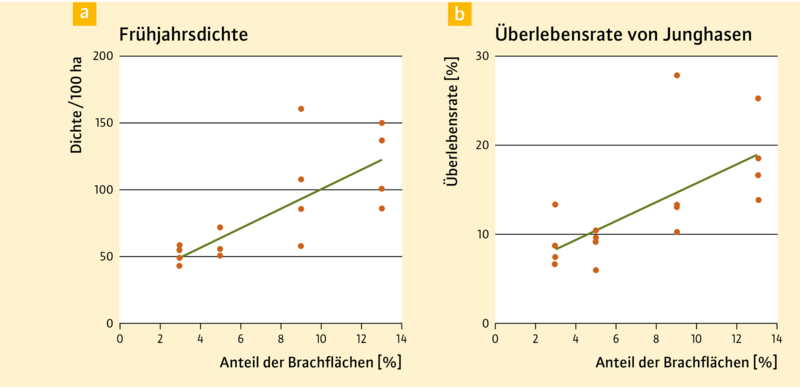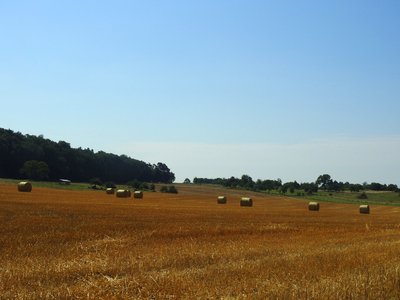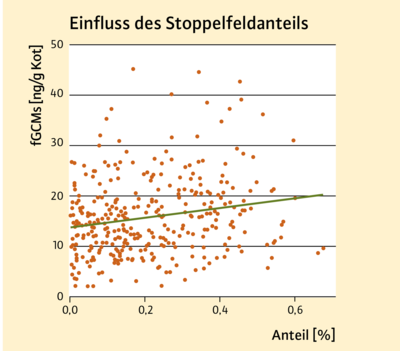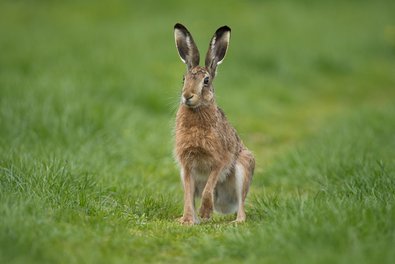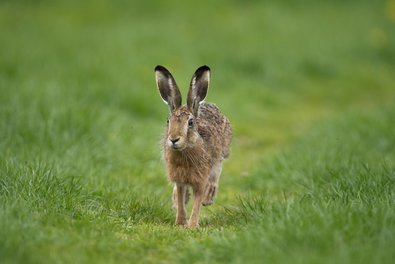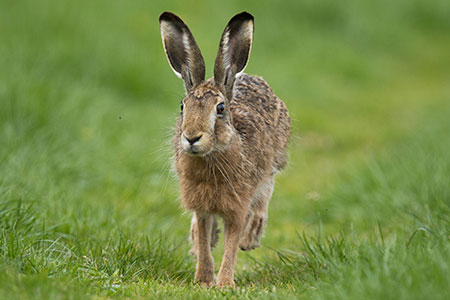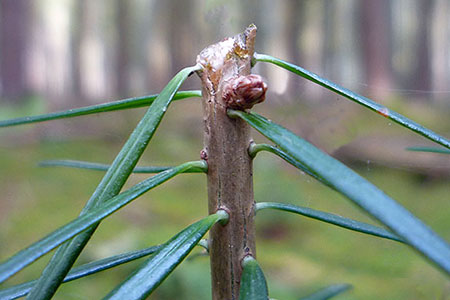Originally, the brown hare (Lepus europaeus) came from the grassy steppes of Eurasia, where it is relatively rare, with population densities of two animals/100 ha. It was only through human clearing activities and the opening up of the landscape that an ideal new habitat emerged for what is really a steppe-dweller. As a beneficiary of cultivated landscapes, the hare has spread throughout Europe, reaching population densities of up to 160 or more hares/100 ha in some areas. Since the beginning of the 20th century, its populations have however been in decline.
Reasons for its decline
A comprehensive literature search comparing 77 publications from 12 European countries leads us to conclude that the main reason for the decline of the brown hare is the intensification of agriculture. It is not as yet completely clear whether and to what extent the consequences of intensive agriculture are related to the decline in the hare population.
Generally the density of a hare population is determined by several factors, such as climate, site, diseases, predators and human influences (agriculture, road traffic and hunting), and their interactions. A prolonged, severe decline would however have to be caused by reduced fertility and/or an increase in mortality.
Reduced fertility
Studies of uterine scarring as an indicator of fertility in female hares found no difference in birth rate between areas with high and low population densities. In areas with lower population densities, the proportion of young hares among those killed in autumn is however lower (Fig. 2).
The reason for the different population densities seems thus to be more a question of the increased mortality of young hares than a reduced fertility in the female hares.
Reduced survival rate
The survival rate of the young animals is decisive for the population density of the European hare. Analyses of stomach contents show that in their grazing, hares strongly select plants with a high proportion of unsaturated fatty acids and crude protein. This high-energy diet is crucial for the rearing and development of young hares. Female hares that have food with a high fat content available to them can not only produce more milk per young animal, but also milk with a higher energy content.
Given the reproductive strategy of hares, which means the young animals can be left alone temporarily in harsh environmental conditions almost all year round, a high energy supply through the milk is crucial if the animals are to survive.
Modern intensively farmed landscapes have reduced plant diversity in many places, however. This can lead to a diet-related change in the lactation performance of the doe and thus to a reduction in the survival rate of young hares.
Intensification of agriculture
A change in habitat conditions due to the intensification of agriculture seems to be the so-called “super factor” when it comes to the decline of the European hare. But what are the exact causes that have contributed to its decline?
One milestone with regard to changes in the cultural landscape was the invention of artificial fertiliser through the Haber-Bosch process at the beginning of the 20th century. The previously necessary three-field system of agriculture, in which a third of agricultural areas lay fallow at any one time, disappeared, and with it diverse structures.
The land consolidation that followed in the 1960s reduced the remaining proportion of diverse structures still further. It is the unmanaged areas such as hedgerows, field margins, and fallow land in particular that are particularly attractive habitats for the brown hare. They offer cover, high-energy grazing and valuable space to retreat to, which can for example reduce population losses caused by agricultural measures.
The effects of weather conditions and predators are also amplified by the loss of cover and grazing. The importance of these structures is emphasised in a study in Lower Austria that showed a positive correlation between the population density of brown hare with the proportion of fallow land in the area (Fig 4a). The survival rate of young hares is also positively influenced by the proportion of fallow areas (Fig. 4b).
Other side effects of intensive agriculture are the enlargement of farming units, fast-working machinery, and monotonous crop rotations. It can thus be assumed that harvesting processes in a modern agricultural landscape lead to a change in the habitats within a short period of time and thus have a significant influence on the spatial use of the brown hare. The suitable habitats that remain are often far apart, which can lead to an increase in the energy required by the hare. Studies show that the grain harvest leads to a significant increase in the size of the weekly foraging areas. The remaining and thus preferred habitats may also draw large numbers of hares. This may cause social stress and increase the risk from predators.
Do harvesting operations mean stress?
In order to test whether harvesting measures have an influence on the health of brown hares, and if so, what influence, a further study was carried out to measure the glucocorticoid metabolites in the faeces (fGCM). These metabolites make it possible to evaluate the stress levels of the hares. One aspect that was evaluated was whether the availability of habitats that were not affected by the harvest, such as fallow land, for example, mitigated any negative effect.
With an increasing proportion of stubble fields in the foraging area, higher fGCM-concentrations were found in the hares (Fig. 6). No general increase in the fGCM-concentrations due to the winter grain harvests in the study area was found, however. The results are interpreted to mean that harvesting operations in a small-structured landscape like the study area, with many extensive structures such as fallow areas and hedgerows, do not produce stress in brown hares.
However, this study only investigated small-structured landscapes, so that it cannot rule out the possibility that the harvest may lead to an increase in stress levels for the hare in larger farming units with a lower proportion of extensive structures. Further studies would be required to clarify this.
Summary
For a long time, the diverse and structurally rich cultural landscapes created by humans over centuries in Europe provided very favourable living conditions for the brown hare. Its population densities were even significantly higher than population densities in its original distribution area on the grassy Eurasian steppes. However, due to the intensive transformation of cultural landscapes over the last few decades, the habitat conditions for the European hare have also changed fundamentally. According to present scientific knowledge, the change in habitat conditions can be seen as the main factor in the decline of the hare populations. As well as the loss of key habitat structures, changes in farming management practices and the intensity of management are also crucial factors contributing to the population decline. The extent to which the various environmental measures implemented in agriculture in recent years can contribute to a recovery of the brown hare population should be accompanied by scientific research.
Fig. 7: The European hare is a well-known animal, but its population is increasingly endangered (Picture: Rudolf Vornehm).


